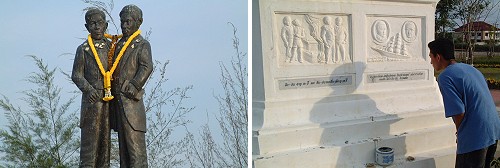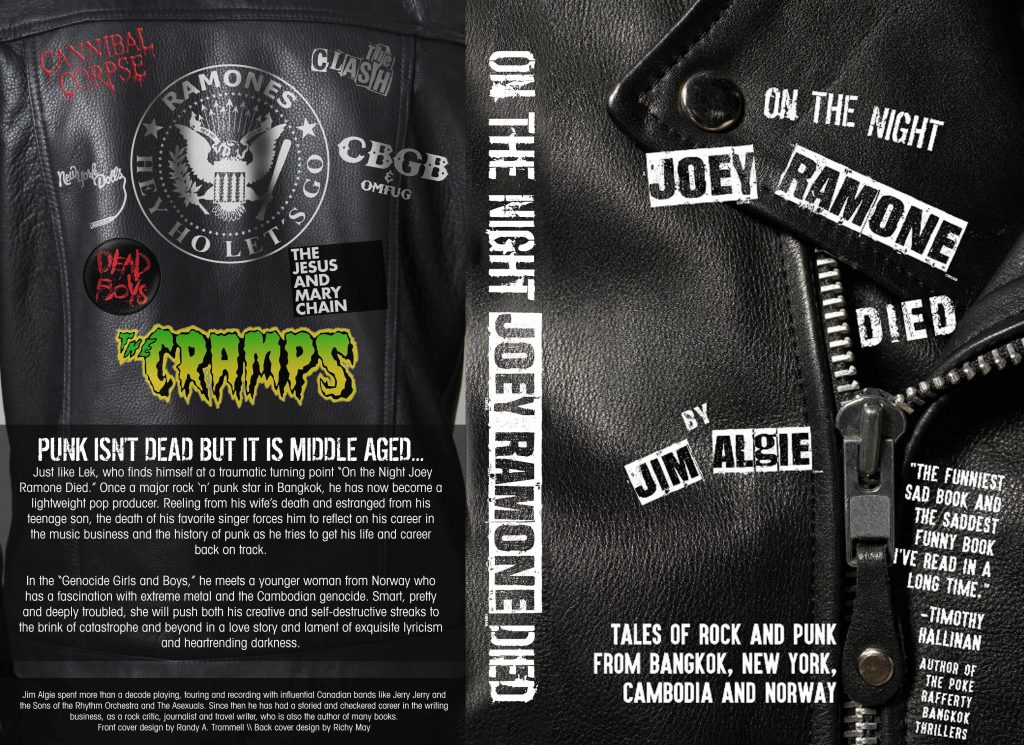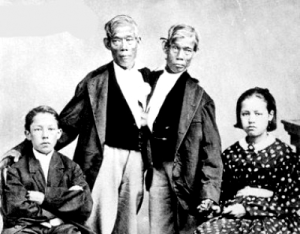Double Lives: Searching for the Siamese Twins
In this excerpt from the book, Bizarre Thailand: Tales of Crime, Sex and Black Magic, Jim Algie examines the remarkable lives of the Siamese twins, Chang and Eng, from growing up as poor fishermen in rural Thailand to becoming the “Eighth Wonder of the World.”
BECAUSE of their brotherly bond made flesh, and their astonishing, perfectly synchronized acrobatics, the original Siamese twins Chang and Eng were billed as the ‘Eighth Wonder of the World’ when, at the age of 18, they arrived in New York in 1829.
For the next decade, they performed for packed houses all over America and Europe in circuses and on freak-show bills with other human oddities, such as the ‘Amazing Wolf Children of Australia.’ Chang and Eng were twice managed by the infamous showman P.T. Barnum (“There’s a sucker born every minute.”), Herman Melville scorned them as a monstrous metaphor for conflicting passions which reside within the same body in Moby Dick; and they put on private spectacles for Queen Victoria and Russia’s Czar Nicholas II. Although they shared no internal organs, and were often derided as a fraud, the brothers were actually joined below their breastbones by a ligament about eight centimetres long and four wide. Otherwise, they both had normal limbs and were healthy. Through their performances – walking on their hands was a showstopper – the twins were already wealthy before they turned 30, and they tried to retire to a family and farming life in the American south, soon to be torn asunder by the Civil War. Over the last decade, their dramatic history has been the inspiration for a pair of much-lauded literary novels – Chang and Eng by Darin Strauss and God’s Fool by Mark Slouka – along with a Singaporean musical helmed by Thai expatriate Ekachai Uekrongtham, who also directed and co-wrote the 2003 film Beautiful Boxer about the transsexual muay thai fighter Nong Toom.
As a result, the steady trickle of foreign and Thai visitors to khram, has become more torrential. Still, Siam’s most famous citizens are not mentioned in any of the major guidebooks to the kingdom and even the promotional literature of the Tourism Authority of Thailand for the province includes nothing about them. Fascinated by their legacy, and these sins of omission, I went in search of relics from Chang and Eng’s past. Much of the twins’ early life is still a matter of conjecture. Both the musical and the two novels are accurate, however, in documenting their birth in a floating riverside home, 70 kilometers southwest of Bangkok, during the rainy season of 1811. If the old bamboo-and-thatch floating homes have long since been replaced by a Caltex oil refinery and some fish sauce factories, traces of the maritime life Chang and Eng once led (their father was a fisherman) are still high water marks in the country’s smallest province. Head down the roads beside the Mae Khlong River near their birthplace to see fishing trawlers on the water and boatyards along the banks. Workmen – pounding, polishing and patching – cling to ten metre-high scaffolds of bamboo hanging from the sides of trawlers. And the stench of rotten fish will make you squint.
A few kilometers north, past tiger-prawn farms, salt flats and ornate temples, is Don Hoy Lot, where the river’s mouth kisses the Gulf of Thailand. Here, the banks are crowded with enormous wooden restaurants up on stilts. And the seafood is as famous as the crab-eating macaques that scamper across the mudflats around dusk in search of their staple diet.
As conjoined children of mixed Siamese-Chinese parentage, Chang and Eng were jeered at and taunted endlessly by their peers. Worse, much worse, was how they came to be blamed by superstitious Siamese for causing a cholera epidemic which killed 30,000 people and left the river clogged with corpses. In the Singaporean production, Chang and Eng: The Musical, a song titled ‘Living Curse’ details their frightful ordeal at the hands of a potential lynch mob. But what sustained the twins in their most despairing hours? In the opinion of Kent Low, the musical’s composer from Malaysia, it was the unconditional love of their mother. This motif has played well in Asia: the musical is the longest-running theatrical work in Singaporean history, was well received in Bangkok, and also became the first English-language musical ever staged in China towards the end of the millennium, where the composer told me, “We were treated like rock stars.”
Today, every Thai person knows who the Siamese twins are. But most would not recognize the names Chang and Eng. In Thai, the twins are known as ‘In Jan.’ It’s an auspicious name, meaning ‘Earth Moon.’ But it does lead to the common misconception that they were one entity. Not so. The brothers had very different demeanors: Chang was gregarious and playful, whereas Eng tended to be more withdrawn and studious. In Thai history books, children learn that the brothers were the favorite performers at King Rama II’s court. Renowned as a patron of the arts and comedy troupes, the monarch often had them perform at the Grand Place in Bangkok. It has been speculated that his patronage saved them from the wrath of superstitious villagers.
Like the twins, King Rama II was also born in Samut Songkhram, where a park featuring a museum of the monarch’s personal effects, a garden with 100 different kinds of plants mentioned in Thai literature, and an open-air stage for annual performances of masked dramas on Thai Artist’s Day, February 24, is named after him in the provincial capital. As adolescents, Chang and Eng helped provided for their hard-luck family by raising ducks and selling their eggs. Bigger than chicken eggs, and with a darker yolk, duck eggs are a crucial ingredient in the piquant seafood salad called yum, in rice porridge, and, when mixed with coconut milk and sugar, in many Thai desserts. The brothers would also have known how to make one of the province’s specialties – ‘thousand-year-old eggs.’ To preserve them, the duck eggs are boiled in salty water and left for a week to soak. They are then wrapped in rice husks and earth and packed away in a box for up to a year. Even today, local fishermen take a good supply of them on long journeys for protein.
AMPHAWA DISTRICT
Along one of the province’s many canals, we stayed in an old fashioned Siamese-style house with a verandah overlooking the water. The roofless shower outside in the garden was overhung by the cannonball-sized fruits of a pomelo tree. This was one of the ‘home-stays’ run by local families in the Amphawa District. Along with appetizing local meals, Moo Baan Song Thai also offered boat tours of a floating market, fruit orchards, Wat Amphawan Chetiyaram where King Rama II’s ashes are interred, and a nocturnal outing to watch fireflies. Even without booking a tour all we had to do was sit on the verandah and watch a portal into the past open before our eyes. In the early morning, with birds gossiping and fish splashing, monks in saffron robes paddled down the canal, just as they have done for centuries. The Buddhist faithful congregated on rickety piers to put plastic bags of food in the monks’ alms bowls. A short time later, a wizened old woman in a conical hat paddled by to serve us steaming bowls of noodles right on the waterfront. Because the canals and weatherworn buildings of wood have been so well preserved, the Amphawa District won a UNESCO prize for Cultural Conservation. Those enticements, and a ‘floating market’ in the early evening (yet to be watered down by mass-market tourism), have made the capital a favourite escape for weekend parolees from the concrete prison and workaday world of Bangkok. After breakfast, I asked Anchana if she’d ever learned about the twins from Thai history books. She said she had, but did not know much about their later lives. I explained how they married sisters in North Carolina, adopted the surname of Bunker, and sired 21 children.
Anchana looked quizzical. So I told her about Darin Strauss’mnovel, Chang and Eng, and a middle chapter entitled ‘The Mysteries of the Bridal Bed’ that details how the twins lost their virginity. After their wedding in 1843, the conjoined brothers agreed that when one of their wives was in bed with them, the other brother would go into a trance and try to be mindless. When he was sleeping with his wife, Sarah, for the first time, Eng thought, “I felt my wife had become a strange part of me, not integrated fully – but not fully only because this new part of me was experiencing its own pleasure. In my hand, her hand, trembling and weak, her fingers hooked around mine – and the only way to describe what I experienced is as a new-sprung void in my chest, sucking out a solitary life’s worth of loneliness and wanting now to be filled with something new.” Anchana’s next question was whether their children were normal.

The museum dedicated to the Siamese twins. Photos by Richard Barrow.
SIAMESE TWINS MUSEUM
To find out, we visited the museum dedicated to the original Siamese twins, four kilometers from the centre of Samut Songkhram city. Outside the museum stands a statue of the twins alongside a full-scale replica of their floating home. Even though it was early on a Friday afternoon, this sporadically open and frequently shut museum was closed, necessitating a flurry of increasingly angry phone calls from Anchana to local authorities in order to get them to open it for us. No wonder so many Thais fear the flare-gun tempers of the Southerners. But her persistence paid off; they came down and opened it for us. This was the most pitiful museum I have ever seen. Even Hitler’s final bunker must’ve been a cheerier place. Half of the old posters and photos were propped up against concrete pillars and the bare concrete floor was salted and peppered with bird droppings. Whatever its shortcomings – and they are legion – the gallery of fading images provided some touching glimpse into the twins’ personal and professional lives: their wives, their children, their one-time manager P.T. Barnum, and a few of their old circus posters. Most of their kids looked normal and healthy. The portrait of their two lovely daughters – Eng’s Kate, who looked Asian, and Chang’s Nannie, who looked American – was particularly heartrending when I read the caption detailing how both daughters died of tuberculosis at the age of 27.

Lithograph of Siamese twins
The true sideshow connoisseur will not want to miss the promotional photos for their final, disastrous tour in 1866 after the Civil War had devastated their farm in North Carolina and their slaves were freed. By that stage, the twins were already in their 50s, their star had dimmed, and Chang, once the gregarious wise cracker of the duo, had become a gloomy alcoholic. Eng, a lifelong teetotaler, was repulsed by his brother’s habit, partly because the alcohol had a physical effect on him, too. Doubly defeated, their performances became erratic and they made little money. The officials assured us that thanks to a recent visit by some of the twins’ distant relatives, who had promised additional funding, the museum would be undergoing extensive renovations. I hope that’s true. As it stands now, the local prejudice against the twins, and the superstitions surrounding them, have barely changed in almost two centuries. Though rumours continue to persist in 2018 that the museum will receive a substantial upgrade.
For many visitors to the province, the highlight is an evening ride via long-tail boat to see the nesting grounds of fireflies. Motoring along the dark canals, a fan of light from the boat illuminated long-abandoned houses on stilts and bats swooping across the water. In places the foliage was so thick, it blocked military battles between China and Japan were like, as well as the lay of the land in ‘Green Lantern Lane,’ Bangkok’s tenderloin of the ‘50s.
This trip into the swampy heart of Siamese darkness was suddenly lit up as the mangrove trees growing out of the muddy banks blinked on and off with thousands of fireflies making quicksilver flashes. When boat stopped Anchana reached up to catch one, watching it blink on and off for a few seconds between the chinks in her fingers before she set it free. On the way back to our canal-side hideaway, I imagined the two young twins watching the fireflies beam their SOS of loneliness some two centuries before us. In spite of all the bad blood between them caused by Chang’s alcoholism and Eng’s embitterment, twinned with their mutual poverty, when Eng woke up in the middle of a cold January night to find his brother dead beside him, the final act of his life was one of reconciliation. It was witnessed only by his wife Sarah: “He twists away from her – he draws his brother closer to him. Eng takes his twin into his arms: This is the image Sarah keeps of her husband for the rest of her life. Eng dies.” Although Strauss has used poetic license to recreate their final hours, it is true that the brothers died within hours of each other. An engraving on the side of twins’ statue outside the museum in Samut Songkhram shows that even in death they could not escape the morbid voyeurism that turned their lives into a lifelong sideshow: Their corpses were sent to a hospital in Philadelphia for an autopsy and the doctors made a plaster cast from them. But the connecting ligament, which helped to bring them from a floating hovel to the court of King Rama II, from being the ‘Eighth Wonder of the World’ to family men and farmers, was never severed.
The original Siamese twins are buried in a double coffin in North Carolina.
Pick up a hard copy or ebook of Bizarre Thailand at Amazon to read more freaky tales like this one about the original Siamese twins.
Jim Algie has written about punk history, his own experiences as a musician, and the life of a falling rock star trying to stage a comeback in his latest book, On the Night Joey Ramone Died: Tales of rock and punk from Bangkok, New York, Cambodia and Norway, available from Amazon as an ebook for US$2.99, and now in an expanded paperback edition that includes a 130-page nonfiction bonus section of “Rock Writings and Musical Memoirs,” including autobiographical pieces like “My Close Encounters with Rock Stars” (Joe Strummer, the Pixies, Pearl Jam, Soundgarden, Ice-T and Leonard Cohen, as well as “My Last Show and Worst Onstage Disaster” that chronicles the musician-turned-author’s near-death experience at a gig in Berlin. The paperback is available only from Amazon for US$12.99.

New paperback cover of On the Night Joey Ramone Died




Recent Comments